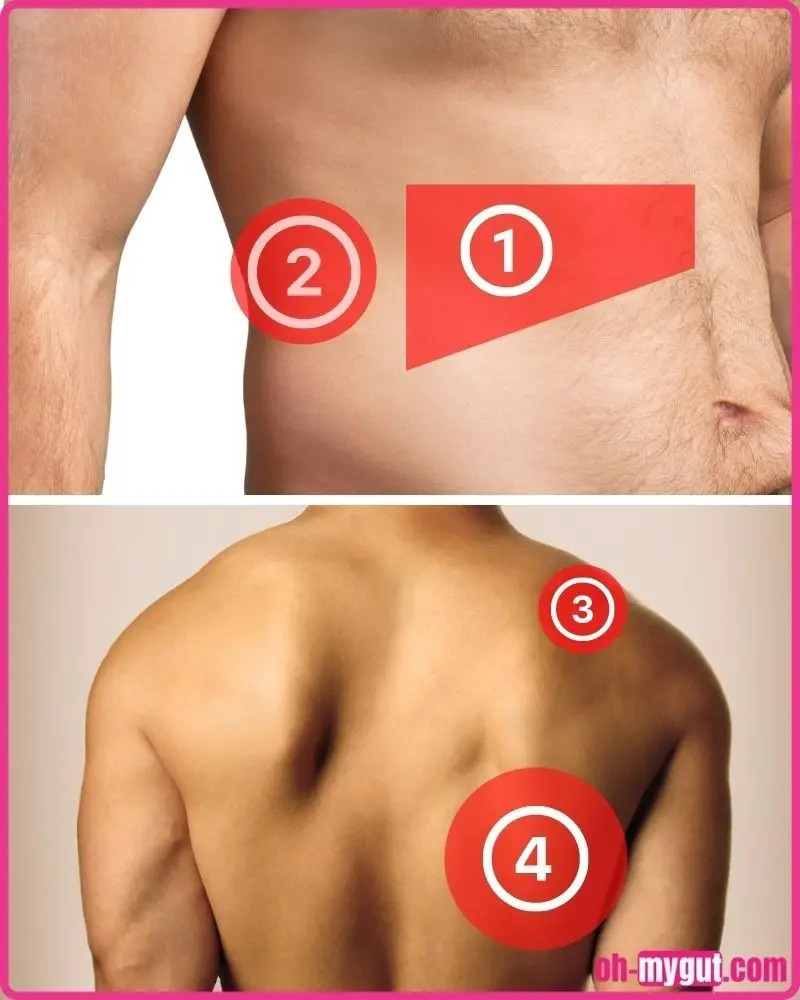4 Causes of Pain in Liver Area That Comes and Goes.
Our content is not intended nor recommended as a substitute for medical advice by your doctor. Use for informational purposes only.
Pain in the liver area (upper right abdomen) is not often due to liver diseases. Most liver diseases such as fatty liver disease, chronic hepatitis, and liver cirrhosis are painless.
Pain in the liver area can arise from other closely related organs such as:
- The gallbladder: as with gallstones, acute cholecystitis.
- The bile ducts include bile duct obstructions, acute cholangitis, and sphincter of Oddi dysfunction.
- The right colon, as with Irritable bowel syndrome, IBS, infections, etc.
- And rarely the liver as with acute hepatitis, liver congestion, portal vein thrombosis, Budd-Chiari syndrome, etc.
Today, We will discuss (IN-DEPTH) the common possible causes of pain in the liver area that comes and goes.
1 . Biliary pain.
Biliary pain originates from the gallbladder and/or the bile canal connecting the gall bladder to the intestine and the liver.
The gallbladder and the bile duct diseases are more common causes of pain in the upper right abdomen (the liver area) that comes and goes.
Common diseases include:
A. The gallstone disease.
Gallstones are typically cholesterol stones found inside the gallbladder (sometimes also found in the biliary).
Biliary pain is a dull constant pain attack in the liver area (upper right abdomen). The biliary pain often comes and goes in episodes (each lasts 30 minutes to a maximum of 6 hours).
The full characteristics of biliary colics are in the table below (reference):
Biliary colic (Uncomplicated gallstone). | Description |
1. Site | Usually, The right upper quadrant of your abdomen. |
2. Spread | – The pain may spread to the back of the right shoulder. – Also, it spreads to the epigastric area. |
3. Character | Constant builds up then disappears gradually. |
4. Duration | At least 30 minutes. It may last up to 6 hours. |
5. Relation to food | – Triggered by foods (especially fatty food and large meals. – However, it can start spontaneously. |
6. NOT related to: | Movement, bowel movements, or the passage of flatus. |
7. Nausea | Often Present, severe. |
8- Commonly associated symptoms | Vomiting, sweating during the attack. |
6. Unusual symptoms. | – Heartburn and chest pain. – Bloating, fullness. – Early satiety. – Isolated epigastric pain. |
6. Symptoms NOT associated: | – Fever. – Jaundice. – Prolonged pain for more than 6 hours. – Extreme tenderness over the gallbladder (Murphy’s sign). – Vomiting of blood, blackish stool (PUD). |
B. Acute cholecystitis.
Acute cholecystitis is often a complication of gallstone disease. Obstruction of the gallbladder opening results in infection and inflammation of the gallbladder.
Acute cholecystitis is an urgent medical condition. If left untreated, severe complications may occur, such as gallbladder rupture.
The pain in the liver area from acute cholecystitis resembles the uncomplicated gallstone pain, with the following differences:
- The gallbladder pain is often more severe and steady.
- The biliary colic is often more prolonged (pain lasting for more than 6 hours usually indicates acute cholecystitis or bile duct stone).
- Radiation to the right shoulder or back is more common.
- Fever and ill-feeling are frequent.
- Severe localized tenderness above the gallbladder area (The right-upper quadrant just below the rib cage). The severe local tenderness over the gallbladder area is Murphy’s sign (absent on uncomplicated biliary colic).
- Nausea and vomiting are more common.
C. Other less common diseases.
Other less common diseases of the gallbladder and biliary system that cause recurrent pain in the liver area include:
- Sphincter of Oddi Dysfunction: It is a ring of muscle at the opening of the bile duct into the duodenum. Failed relaxation or delayed relaxation of the sphincter produces biliary-type pain.
- Acute cholangitis: inflammation of the bile ducts with a triad of fever, jaundice, and right upper quadrant pain in the liver area.
- Biliary tumors.
- Immune-mediated biliary diseases such s Primary biliary cholangitis.
MORE: Does Your Liver Cause Pain After Eating?
2. Liver pain.
Liver pain is a less common pain of pain in the liver area that comes and goes due to two reasons:
- The liver itself is insensitive to pain; Liver pain often results from the rapid stretch of its capsule, as with acute hepatitis, liver tumors, etc.
- Liver pain tends to be constant (lasting for long days, weeks, or months). A pain that comes and goes frequently is more of a biliary or gastrointestinal tract origin.
Characters and symptoms of liver pain:
- The liver pain is often constant, dull aching in nature.
- Location: in the upper right abdomen (the liver area), it may also be felt in the lower right rib cage, the right shoulder, and the mid-back at the right side.
- Duration: The liver pain is more prolonged (for days, up to months, or years). It rarely comes and goes.
- Some diseases may cause a more severe sharp or pulsating pain.
- Symptoms of associated liver disease include jaundice, dark urine, light-colored stools, swollen abdomen (ascites), swollen lower limbs, weight loss.
The image below illustrates the common liver pain locations:

For a more detailed guide about liver pain locations, See this article.
Where do you Feel Liver Pain? (Pain Location Diagram).
Chronic liver diseases such as fatty liver disease, chronic hepatitis, and liver cirrhosis are often painless. Liver pain is a rare presentation of liver disease, and it is found mainly in malignant tumors, acute inflammation, and vascular liver diseases.
Common painful liver disease and conditions:
- Acute inflammations of the liver (acute hepatitis).
- Liver congestion (often due to congestive heart failure or chronic chest diseases).
- Liver abscess or cysts.
- Liver tumors (benign or malignant).
- Portal vein thrombosis.
- Budd-Chiari
- Perihepatitis (Fitz-Hugh-Curts) syndromes.
- Chronic liver diseases as fatty liver disease, chronic hepatitis, and liver cirrhosis RARELY cause liver pain.
MORE:
- Does Live Pain Hurt When you Move? 5 Facts, Doctor Explains.
- Sharp Liver Pain: 7 Causes & Mimics.
- Liver pain in The back: 10 Causes & Mimics.
- Fatty Liver Pain: Causes, Mimics, and Treatment.
- Fatty liver 101: Causes, Symptoms, Complications, and life expectancy.
3. Colonic conditions.
Diseases affecting the parts of your colon (primarily the right ascending and the transverse colon) may cause pain in the liver area that comes and goes.
However, Colonic and small intestinal diseases tend to be more diffuse over the abdomen. Rarely, Colonic and other intestinal conditions can cause right upper abdominal pain that comes and goes.
Examples include:
- Trapped wind (gas pain) in the right colon.
- Irritable bowel syndrome: A functional bowel disease characterized by abdominal pain that comes and goes with changes in bowel habits and stool form.
- Inflammatory bowel disease: chronic inflammation of the digestive tract with ulceration, abdominal pain, fever, weight loss, bloody stool. Famous subtypes of inflammatory bowel disease include ulcerative colitis and Crohn’s disease.
- Localized inflammation or infection in the right colon (infectious colitis).
- Colon cancer.
For a detailed explanation of colon pain, Read this article: IBS vs. Non-IBS pain at the right side.
4. Other causes.
Less common causes of pain in the liver area that comes and goes:
- Pain from the muscles of the abdominal wall (muscle strain): very common.
- Pleurisy: an inflammation of the lung envelope (The pleura).
- Trauma to the upper right abdomen.
- Right kidney stones, gravels, or inflammation.
- Fibromyalgia.
- Other functional syndromes of pain include chronic fatigue syndrome, Multiple chemical sensitivity syndrome, and others.
- Psychological dysfunction as with depression, anxiety, and somatization diseases.
- Intercostal nerve inflammation (intercostal neuritis).
- Peptic ulcer disease and chronic gastritis.
- Functional dyspepsia.
- Anterior cutaneous nerve entrapment syndrome (reference).
In conclusion, Any pain that comes and goes in the liver area is challenging to figure out its cause by yourself. Moreover, pain diagnosis often requires abdominal imaging (such as abdominal ultrasound) and laboratory investigations.
Don’t rush to conclusions; More than 95% of the cause of pain in the liver area are not serious.
Other Articles that will help you:
- Seven causes of pain where the gallbladder was removed years ago.
- IBS Vs. Non-IBS right abdominal pain.
- 5 Mimics of gallbladder pain.
- 6 Commonest Liver Lesions & When to Worry: (Benign vs. Malignant).
- Evidence-based
- Written by a doctor.

Related Posts:
- Liver Pain in Females: Location, Causes, Pregnancy, & More.
- Fatty Liver Pain: Causes, Mimics, and Treatment;…
- Liver Complications after Bariatric Surgery.
- 5 Causes of Elevated Liver Enzymes & Negative Ultrasound
- How Long does it Take to Reverse a Fatty Liver? (5 Facts).
- 8 Warning Signs of a Dying Liver (Hepatologist Explains).










